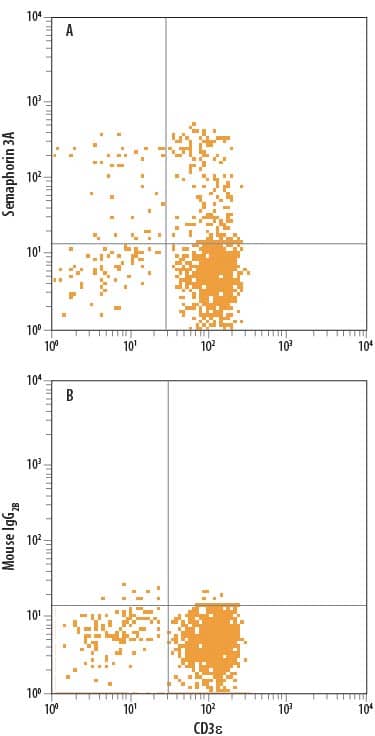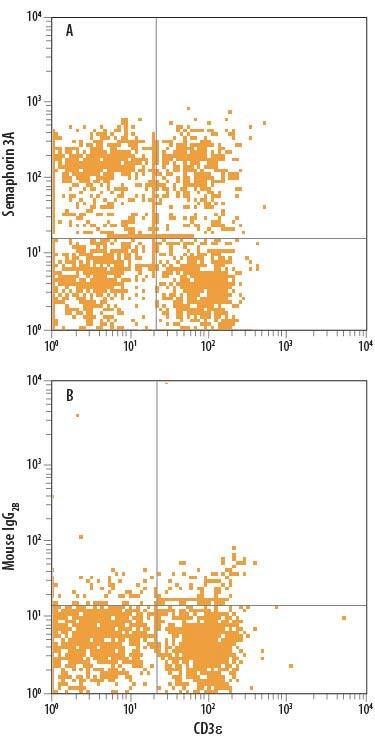Human/Mouse Semaphorin 3A Alexa Fluor® 488-conjugated Antibody
R&D Systems, part of Bio-Techne | Catalog # IC1250G


Key Product Details
Validated by
Species Reactivity
Validated:
Cited:
Applications
Validated:
Cited:
Label
Antibody Source
Product Specifications
Immunogen
Lys26-Val771 (Arg555Ala, Arg552Ala)
Accession # Q14563
Specificity
Clonality
Host
Isotype
Scientific Data Images
Detection of Semaphorin 3A in Human PBMCs by Flow Cytometry.
Human peripheral blood mononuclear cells (PBMCs) treated with PHA were stained with Mouse Anti-Human CD3e APC-conjugated Monoclonal Antibody (FAB100A) and either (A) Mouse Anti-Human/Mouse Semaphorin 3A Alexa Fluor® 488-conjugated Monoclonal Antibody (Catalog # IC1250G) or (B) Mouse IgG2BAlexa Fluor 488 Isotype Control (IC0041G). To facilitate intracellular staining, cells were fixed with Flow Cytometry Fixation Buffer (FC004) and permeabilized with Flow Cytometry Permeabilization/Wash Buffer I (FC005). View our protocol for Staining Intracellular Molecules.Detection of Semaphorin 3A in Mouse Splenocytes by Flow Cytometry.
Mouse splenocytes treated with PHA were stained with Mouse Anti-Human CD3e APC-conjugated Monoclonal Antibody (FAB100A) and either (A) Mouse Anti-Human/Mouse Semaphorin 3A Alexa Fluor® 488-conjugated Monoclonal Antibody (Catalog # IC1250G) or (B) Mouse IgG2BAlexa Fluor 488 Isotype Control (IC0041G). To facilitate intracellular staining, cells were fixed with Flow Cytometry Fixation Buffer (FC004) and permeabilized with Flow Cytometry Permeabilization/Wash Buffer I (FC005). View our protocol for Staining Intracellular Molecules.Detection of Semaphorin 3A in U118-MG cells by Flow Cytometry
U118-MG cells were stained with Mouse Anti-Human/Mouse Semaphorin 3A Alexa Fluor® 488-conjugated Monoclonal Antibody (Catalog # IC1250G, filled histogram) or isotype control antibody (Catalog # IC0041G, open histogram). To facilitate intracellular staining, cells were fixed with Flow Cytometry Fixation Buffer (Catalog # FC004) and permeabilized with Flow Cytometry Permeabilization/Wash Buffer I (Catalog # FC005). View our protocol for Staining Intracellular Molecules.Applications
Intracellular Staining by Flow Cytometry
Sample: U118-MG cells
Formulation, Preparation, and Storage
Purification
Formulation
Shipping
Stability & Storage
- 12 months from date of receipt, 2 to 8 °C as supplied.
Background: Semaphorin 3A
The Semaphorins constitute a large family of secreted, GPI-anchored and transmembrane cell signaling molecules. Depending on their domain organization and species origin, these proteins can be classified into eight groups. To date, at least 19 vertebrate Semaphorins belonging to five groups (class 3 through 7) have been identified. All Semaphorins contain a conserved, 500 amino acid (aa) Sema domain at the amino terminus. Semaphorins are best known for their roles in axon guidance during neuronal development. Semaphorins are also expressed in non-neuronal tissues and are involved in angiogenesis, hematopoiesis, organogenesis, and the regulation of immune functions (1, 2).
Class 3 Semaphorins (Sema3) are secreted proteins containing a Sema domain, an immunoglobulin c2-like domain and a basic domain near the carboxyl tail. Sema3A (also referred to as SemaIII, SemD and Collapsin) cDNA predicts a 771 aa precursor protein with a putative 25 aa signal peptide (1‑3). Bioactive Sema3A is a disulfide-linked dimer (4). The bioactivity is increased after proteolytic processing by a furin-like endoprotease near the carboxy-terminus (1). The functional receptor complex for Sema3 is composed of two distinct transmembrane proteins: Neuropilin-1 (Npn-1) and Plexin-A. Npn-1 binds directly to Sema3A with high-affinity and confers specificity. Plexin-A interacts with Npn-1 to increase the affinity of the complex for Sema3A and serves as the signaling subunit in the receptor complex (1, 2, 5).
References
- Nakamura, F. et al. (2000) J Neurobiol. 44:219.
- Goshima, Y. et al. (2002) J. Clin. Invest. 109:993.
- Kolodkin, A.L. et al. (1993) Cell 75:1389.
- Koppel, A.M. et al. (1998) J. Biol. Chem. 273:15708.
- Yu, T.W. et al. (2001) Nature Neurosci. Supplement 4:1169.
- Luo Y. et al. (1993) Cell 75:217.
Alternate Names
Entrez Gene IDs
Gene Symbol
UniProt
Additional Semaphorin 3A Products
Product Specific Notices
This product is provided under an agreement between Life Technologies Corporation and R&D Systems, Inc, and the manufacture, use, sale or import of this product is subject to one or more US patents and corresponding non-US equivalents, owned by Life Technologies Corporation and its affiliates. The purchase of this product conveys to the buyer the non-transferable right to use the purchased amount of the product and components of the product only in research conducted by the buyer (whether the buyer is an academic or for-profit entity). The sale of this product is expressly conditioned on the buyer not using the product or its components (1) in manufacturing; (2) to provide a service, information, or data to an unaffiliated third party for payment; (3) for therapeutic, diagnostic or prophylactic purposes; (4) to resell, sell, or otherwise transfer this product or its components to any third party, or for any other commercial purpose. Life Technologies Corporation will not assert a claim against the buyer of the infringement of the above patents based on the manufacture, use or sale of a commercial product developed in research by the buyer in which this product or its components was employed, provided that neither this product nor any of its components was used in the manufacture of such product. For information on purchasing a license to this product for purposes other than research, contact Life Technologies Corporation, Cell Analysis Business Unit, Business Development, 29851 Willow Creek Road, Eugene, OR 97402, Tel: (541) 465-8300. Fax: (541) 335-0354.
For research use only

